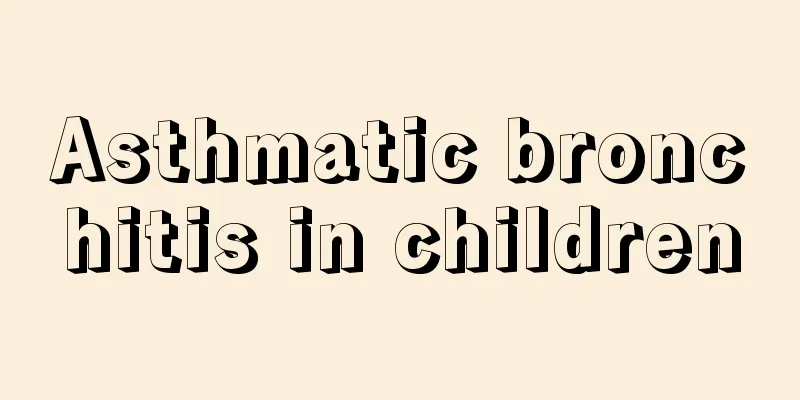Children have recurring low-grade fever

|
Children's resistance is relatively poor, and many children have recurring low-grade fevers. The occurrence of this problem has a relatively large impact on the child's health. If it is not cared for and treated in time, it will have a great impact on the child's health and even his or her development. Below, we will introduce in detail the causes and treatment methods of children's repeated low-grade fever! 1. Why do children have repeated fevers? Because children have poor ability to adapt to the external environment and their immune systems are not yet fully developed, any discomfort can easily lead to fever symptoms, or their body temperature may rise again quickly after taking medicine to reduce the fever. Especially in the hot summer, if parents use the air conditioner improperly or the baby drinks less water and cannot adapt to the high temperature weather, it will cause repeated fever. There are many causes of fever: mainly bacterial and viral invasion, which cause respiratory and gastrointestinal infections and lead to fever. What parents can do is to provide adequate nutrition according to the child's age and physical development, and add complementary foods in a timely, reasonable and balanced manner. Parents should be especially reminded that if their child has a fever for more than three consecutive days without improvement or if the baby has a high fever or convulsions, they should seek medical attention in time to identify the cause and provide symptomatic treatment. 2. What to do if your child has repeated fever 1. When the body temperature is below 38.5℃, physical cooling is the preferred intervention. Fever is the most common symptom of infectious diseases in children. The treatment of fever can be roughly divided into "physical treatment" and "drug treatment". Generally speaking, when a child's body temperature is below 38°C, there is no need to use drug treatment, but choose the correct physical cooling method. For example, applying a fever-reducing patch, drinking plenty of water, and taking a warm bath can all help lower body temperature. 2. Infants and young children with a body temperature above 38.5°C need drug treatment. If you find that your child's body temperature has exceeded 38.5℃, parents should closely observe the child's condition so as to respond in time. For infants and young children, when their body temperature exceeds 38.5℃, they need to be given medication. 3. If the body temperature is above 39°C, medication should be taken under the guidance of a doctor. When a child's body temperature exceeds 39°C and is considered a high fever, Western medicine treatment is usually chosen. Currently, ibuprofen and paracetamol are commonly used antipyretics in clinical practice. These two types of drugs are relatively safe. But one thing that must be made clear is that parents should use the medication under the guidance of a doctor, especially pay attention to the dosage, and send the baby to the hospital for treatment in time. 3. What should children eat when they have repeated fevers? (1) Rice soup. Rice soup can provide children with carbohydrates. It has sufficient water content, making it easier for sick children to absorb it. Rice soup is obtained by boiling rice and removing the residue. (2) Mung bean soup. Mung beans are benign and have the effects of clearing away heat, detoxifying and relieving summer heat. (3) Fresh fruit juice. In summer, you can drink watermelon juice, which has the effects of clearing away heat, quenching thirst, and promoting diuresis; in autumn and winter, you can drink fresh pear juice, which has the effects of moistening the lungs, clearing the heart, relieving cough, and removing phlegm; fresh orange juice has the effects of removing dampness, resolving phlegm, clearing the lungs, and unblocking the meridians. |
<<: Children love to shake when sleeping
>>: Why is the child's buttocks red?
Recommend
What should I do if my baby has eye mucus?
I believe everyone knows what a baby is. If there...
What is the normal crp value for children?
Many people do not know the meaning of crp. In fa...
What are the symptoms of white spot in children
Vitiligo affects a wide range of people and can o...
Newborn baby face red spots
The health of a newborn baby concerns both new mo...
What are the symptoms of calcium deficiency in infants and young children and how to supplement it?
Many parents are concerned about the physical dev...
Treatment for head impact in infants
Infant head impacts cause our children to suffer ...
What is the reason for the baby's light sleep
Unlike adults who fall into a deep sleep, many ba...
What can children with myopia eat to improve their vision?
Parents are very concerned about their children&#...
How to treat gynecological inflammation in children
In our lives, most women who suffer from gynecolo...
What to do if your baby has spring diarrhea
The temperature in spring is fluctuating, and man...
Why does a three-year-old child urinate frequently?
Parents will report that these children always ur...
What should I do if my baby has heat stroke and fever?
Since babies have relatively poor immunity, they ...
Can children eat more watermelon?
When summer comes, the weather is scorching hot. ...
Symptoms of roseola infantum
For young children, mothers need to take good car...
What are the symptoms of hernia in children?
Many parents are very confused about the fact tha...









